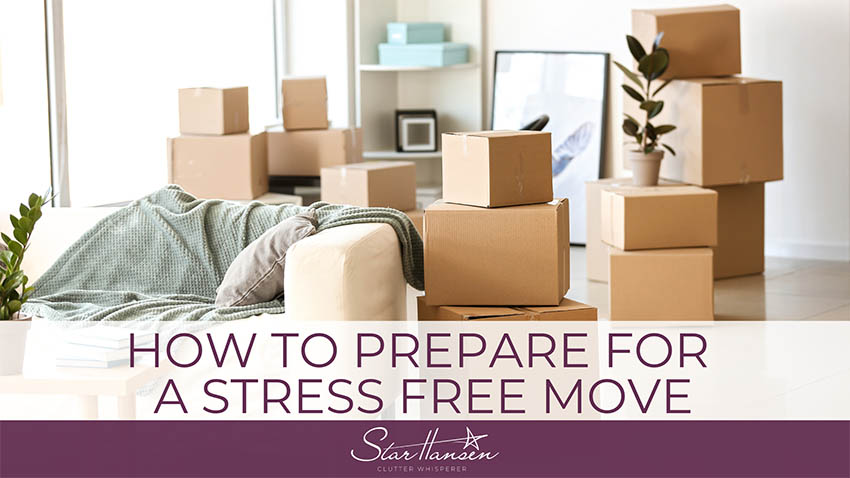How to Prepare for a Stress-Free Move. Ah moving, the wonderful opportunity to pare down and box up everything you own–listed right up there with major life stressors like death, divorce, and a Monday without coffee. It certainly can feel like the worst thing in the world to prepare for a move, but when you’re equipped with the right moving supplies and plenty of muscle, it’s possible to get through it relatively unscathed.
I’ve moved and helped others prepare for a move more times than you want to know over the last 15 years. I’ve seen it all: garages practically bursting at the seams, memorabilia you just can’t part with, movers who move so slow you wonder why you didn’t just do it yourself, boxes of broken dishes, bulky furniture that won’t fit through the door, lost keys to the new house–and that’s only the beginning. But fear not, I’ve learned many tips, tricks, and techniques over the years that will help ensure your move goes much more smoothly.
This article is part 1 of a 2-part series you can use to help you shop for the right supplies, get organized, streamline packing and prepare for a move.
Tip 1–Get the Right Gear
This tip is worth emphasizing: don’t skimp on a good tape gun and tape. Seriously. The best thing you can do, as you survey the landscape of stuff you’ve accumulated, is stock up on the right moving gear. That includes tape and lots of it. Go to the people who do it best–moving supply stores. Don’t waste your time with office supply or hardware stores on this one. I would rather drive two hours to get a good tape gun and tape than a struggle over and over again with tape that sticks stubbornly to the roll and won’t lift, or a tape gun that either doesn’t cut well or sets the tape flying free.
I wish I could say definitively to use a specific brand of tape gun and tape, but what you truly need to do is find the most legitimate moving and packing store in your area. In Los Angeles it’s Box Brothers, in San Jose it’s JDM Packing Supplies. Uline Shipping Supplies is always a solid choice, and they will mail moving supplies out to you. I know, all this talk about tape–but I can assure you that this is one of the seemingly small details that if overlooked, can make or break your move, sometimes literally.
Tip 2–Budget for Boxes
The boxes you choose mostly depends on your moving budget. But you’ll also want to to ask yourself the following questions when determining how to best prepare for a move with the right types of boxes in place:
Am I moving my belongings myself or hiring movers?
If you are preparing for a move yourself and your belongings will be held in the boxes for a short period of time, you can find great boxes at your local grocery or drug store. I also recommend using sites like Freecycle or Craigslist to find used moving boxes someone else no longer needs from their own move.
How much stuff am I moving into storage?
If you need or want to use proper moving boxes, there are many good local choices.
Pro-Tip–Purchase moving boxes from locations that will allow you to return any unused boxes. Moving is expensive enough. The last thing you want is a bunch of moving boxes you didn’t use that you now have to recycle or give away.
What types of fragile or valuable items will I need to move?
You’ll want to secure fragile items like dishes and glassware by wrapping the items in butcher paper or newspaper. You can also use bubble wrap or other recyclable packing materials. For specialty items like your television, artwork, mirrors or framed photos, again I recommend visiting your local moving store or a UPS Store to purchase specialty size art and mirror moving boxes. You can usually fit between 1-4 pieces into each box. This will keep your fragile items safe and sound as you prepare for a move.
Pro-Tip–If something is truly valuable or sentimental, I strongly recommend that you transport it yourself. In all my years of doing moves, it was that one valuable item that was consistently broken by movers every time, no matter how careful they were. One mover once dropped and broke an invaluable 4’ tall custom vase (worth multiple thousands of dollars, made by an artist no longer living) when he was 5 feet from the front door to my client’s new apartment. The standard insurance policies just don’t cover that type of loss.
Tip 3–Know Your Exit Strategy
Yes, one day your move will be over, and when that day comes you’ll want to know your exit strategy. At the end of it all, you’ll be left with more moving boxes and packing supplies than you can handle. Ask your moving company if they can take the extra moving boxes and materials from you to recycle. Make sure to ask about the last possible date you can hand over your moving supplies–that way you know how quickly you’ll have to unpack!
I hope you’ve gotten a lot out of these first 3 key moving tips. Now start forming a moving timeline and checklist to help you get organized around your move. That should also keep you busy between now and next week when I share part 2 of my mini-series on how to prepare for a move.





